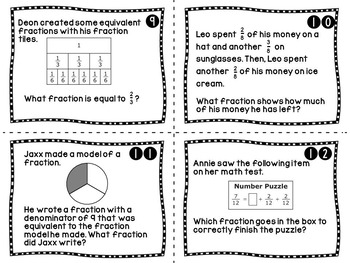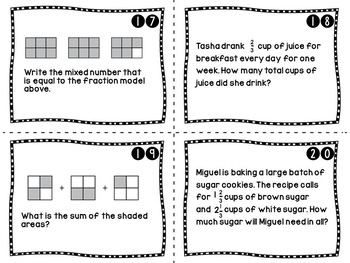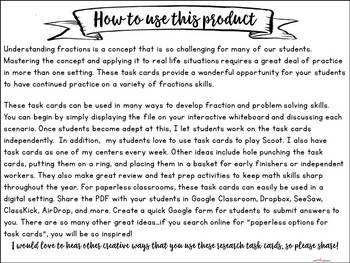Fractions Word Problems Task Cards - Real World Contexts - CCSS Grades 4 & 5
The Kind Librarian - Christie Dalton
1.4k Followers
Grade Levels
4th - 5th, Homeschool
Subjects
Resource Type
Standards
CCSS4.NF.A.1
CCSS4.NF.B.3
CCSS4.NF.B.4
Formats Included
- PDF
Pages
10 pages
The Kind Librarian - Christie Dalton
1.4k Followers
Description
Fraction word problems can be so difficult for many students. These task cards are the perfect tool for students to use in order to practice a wide variety of fractions concepts including: adding fractions, finding equivalent fractions, multiplying a whole number by a fraction, creating mixed numbers from improper fractions, solving word problems, identifying visual models of fractions, and more! The word problems are real-world contexts that students can understand.
Task cards can easily be used for a whole group test prep review, a math center or a fun game of Scoot! For fast finishers or students needing extra practice, laminate the cards and put them on a ring so students can practice independently.
This resource includes: 24 varied fractions task cards, a student recording sheet, and an answer sheet. This product features no colored items on the cards in order to save on ink costs!
My students LOVE using task cards in the classroom, and I hope yours do as well! Please feel free to contact me with any questions about this product or my store at: mypinkclipboard@gmail.com.
Thank you for visiting! I do appreciate positive feedback! Please check out my other task cards sets at my store: My Pink Clipboard.
Task cards can easily be used for a whole group test prep review, a math center or a fun game of Scoot! For fast finishers or students needing extra practice, laminate the cards and put them on a ring so students can practice independently.
This resource includes: 24 varied fractions task cards, a student recording sheet, and an answer sheet. This product features no colored items on the cards in order to save on ink costs!
My students LOVE using task cards in the classroom, and I hope yours do as well! Please feel free to contact me with any questions about this product or my store at: mypinkclipboard@gmail.com.
Thank you for visiting! I do appreciate positive feedback! Please check out my other task cards sets at my store: My Pink Clipboard.
Total Pages
10 pages
Answer Key
Included
Teaching Duration
N/A
Report this resource to TPT
Reported resources will be reviewed by our team. Report this resource to let us know if this resource violates TPT’s content guidelines.
Standards
to see state-specific standards (only available in the US).
CCSS4.NF.A.1
Explain why a fraction 𝘢/𝘣 is equivalent to a fraction (𝘯 × 𝘢)/(𝘯 × 𝘣) by using visual fraction models, with attention to how the number and size of the parts differ even though the two fractions themselves are the same size. Use this principle to recognize and generate equivalent fractions.
CCSS4.NF.B.3
Understand a fraction 𝘢/𝘣 with 𝘢 > 1 as a sum of fractions 1/𝘣.
CCSS4.NF.B.4
Apply and extend previous understandings of multiplication to multiply a fraction by a whole number.





